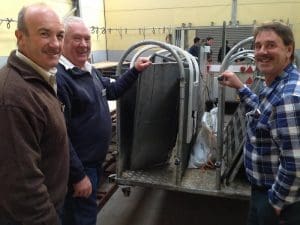
Naracoorte Lucindale Council operations director Steve Bourne, left, with Shepparton saleyards manager Ian McDermott and ALSA executive officer Mark McDonald inspect a portable race reader during the UK tour.
SOUTH Australia’s major prime lamb-selling saleyard at Naracoorte could be among the first interstate saleyards near the Victorian border to implement electronic scanning of sheep and lambs.
The Naracoorte Regional Livestock Exchange’s operations director Steve Bourne said he participated in a tour of UK livestock markets this month because the SA saleyards is only 20 kilometres from the border with Victoria.
He said he would be closely monitoring the implementation of mandatory sheep EID in Victoria and indicated installation of sheep and lamb scanning equipment at the council-owned Naracoorte saleyards might be considered if it generated more competition and was attractive to buyers.
“We don’t know what the impact is going to be for our saleyards – positive or negative – how the Victorian approach is going to impact us.
“But we accept that it will probably follow the same line as what the cattle electronic identification system did, with time,” Mr Bourne said.
Mr Bourne said two processors – SA-based Thomas Foods International and JBS Australia – indicated at a workshop at Ballarat that they wanted sheep and lambs to be identified with electronic tags.
He was not sure there will be a premium paid for EID-tagged sheep and lambs, but there might be discounts for stock not individually electronically identified. No decision has been made on investment in electronic scanning equipment for sheep by the Naracoorte Lucindale Council.
About 20 percent of sheep and lambs sold in the Naracoorte saleyards come from Victoria. Almost one million Victorian sheep and lambs were processed in SA abattoirs in 2015-16, with 46 percent sold in SA saleyards. Victorian processors and restockers also regular buyers of SA sheep and lambs, with about 1.5 million crossing the border in the last financial year.
The NRLE is regarded as the premier livestock selling centre in the state, selling 327,411 sheep and lambs valued at about $35.6 million, and 92,523 cattle worth about $107 million, in 2015-16.
Mr Bourne said he wanted to keep a close watch on the bigger Victoria saleyards — Horsham, Hamilton and Bendigo – as they implement EID for sheep.
“We want to see how they go about it and see how Victoria lands as far as single or double scanning and how the data capture and upload is managed.”
He said it was also not clear yet how saleyards would deal with having only some sheep and lambs electronically identified.
Victoria’s funded EID transition ‘a good move’
Mr Bourne believed Victoria’s decision to support the transition to mandatory EID in sheep and goats with a funding package was “a really good move.” The UK government’s introduction of EID for sheep without support had forced much of the cost onto farmers, he said.
Mr Bourne said after seeing the differences in sheep EID systems between the Netherlands and England, research was needed into single versus double scanning of sheep EID tags in saleyards and what improvements could be made to the current mob-based system.
“Pen scanning is not feasible for the larger Australian saleyards and certainly not at Naracoorte, with its sales of 25,000-30,000 sheep.
“It needs to be highly efficient through race scanners.”
Location of the race scanners was an issue, but race reading of EID tags on sheep was feasible for Australian saleyards if they were placed correctly, Mr Bourne said.
“I’ve thought since this first started that scanning off the ramp and back on is probably the easiest way to do it to configure with our yards.
“But if we need to install scanners somewhere else for a single scan that’s going to require a bit of configuration for us.”
Mr Bourne supported moving to a fully electronic data recording system for sheep and lambs, rather than a “half-and-half” electronic/paper-based system. He noted that English farmers had reverted to the paper-based tag recording system creating delays in the reporting of sheep movements to authorities.
“The saleyards are such a tradition in the UK that when they introduced the electronic system, in some cases we saw that because personalities have been in positions for so long, they won’t use it.
“To see an electronic system in place, but also see a piece of paper go through several hands as it chased the sheep out of the selling ring to the holding pen…..”
Mr Bourne said he was impressed by the use of electronic data as a means of flock improvement in the Netherlands. The UK tour was organised by the Australian Livestock Saleyards Association.



HAVE YOUR SAY